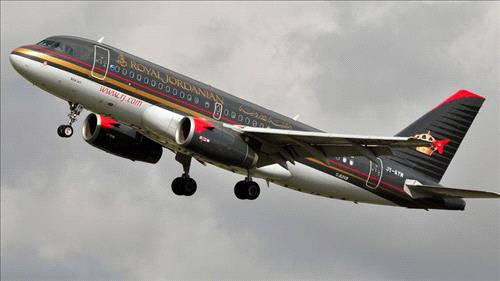Ammon News - AMMONNEWS - European airlines are bracing themselves for a disappointing summer as the threat of terrorism looms large across the continent.
The industry’s jitters are well-founded. Even if airlines manage to keep their planes safe from bombs – something that cannot be taken for granted following recent attacks on Metrojet, Daallo Airlines and perhaps EgyptAir – Europe’s safe-haven status has been dented by a string of atrocities in France and Belgium.
Tourists and business travellers are responding by deferring or cancelling trips to the continent.
With British Airways, Air France, Ryanair and EasyJet all warning of a terror-related downturn, lessons can be learned from one of the Middle East’s most resilient carriers, Royal Jordanian Airlines, which returned to profit last year despite being on the doorstep of several geopolitical crises.
The Jordanian flag-carrier’s troubles began in 2011, when the onset of the Arab Spring pushed it to its worst ever net loss. A temporary reprieve in 2012 gave way to another two years of losses – during which the nearby Syrian conflict emerged as the dominant threat.
Compounded by wars in Iraq to the east and the Sinai Peninsula to the west, Jordan’s thriving tourism sector crumbled amid anxiety about its geographical location.
“Our strategy depends heavily on the Levant area, which has been badly affected by turmoil and unrest,” interim chief executive Suleiman Obeidat told Al Arabiya shortly before the airline announced its 2015 profit. “It’s not Jordan [that tourists evaluate when booking trips] – it’s the Middle East. The perception everywhere is, ‘It’s the Middle East’, not a specific country, and we are in the middle of that.”
As the gravity of the Syrian crisis became clear and hopes of a tourism rebound faded, Royal Jordanian adopted a mixture of traditional and novel restructuring measures to dampen the losses.
Cost multi-tasking
Some of the changes were routine. Tighter cost controls – or, as Obeidat put it, “cost multi-tasking” – provided low-hanging fruit for the airline as it sought to preserve operations with a reduced outlay. Retiring several aircraft from service and boosting labor productivity were key drivers, contributing to a 22% reduction in operating costs last year.
Fuel savings also played a part, thanks to a combination of falling oil prices and the induction of fuel-efficient Boeing 787s.
But other, more radical measures were also taken. With the cancellation of Kiev flights in March, a total of 17 destinations have now been culled from Royal Jordanian’s network.
Eight of the route closures were for security reasons, stemming from renewed violence in Syria, Iraq, Yemen and Libya after the Arab Spring. The other nine suspensions were commercially motivated, reflecting the poor financial performance of some routes to Asia (Delhi, Mumbai and Colombo), Sub-Saharan Africa (Lagos and Accra), the Arab World (Alexandria and Al Ain) and Europe (Milan and Kiev).
The capacity cuts have gradually accelerated, culminating in a 7.5% reduction of Available Seat Kilometers in 2015. That was the same year in which Royal Jordanian returned to the black with a net profit of $23 million.
Capacity realignment
Far from signaling a retreat on all fronts, however, the cutbacks were part of a carefully-managed capacity realignment process.
“As well as closing some of the destinations which were not profitable, we have increased capacity on the routes which were profitable and were feeding the network,” Obeidat said, singling out Saudi Arabia as a “very lucrative” market for Royal Jordanian.
Five new destinations have also joined the network since last summer – Najaf, Tabuk, Ankara, Jakarta and Guangzhou – although the chief executive was reluctant to portray this as a return to growth.
“It’s a continuous process,” he insisted. “It’s looking at all areas, all possible routes, routes of high liability and also new opportunities.”
The key to the strategy was diagnosing both the flag-carrier’s strengths and weaknesses.
Europe-to-Asia connections over Amman will never been its forte, Obeidat admitted, owing to the larger economies of scale enjoyed by the so-called Gulf super-connectors: Emirates, Etihad and Qatar Airways. This was conceded in the decision to pull out of the Indian sub-continent, which Royal Jordanian had been serving at a loss with low-frequency, low-capacity aircraft.
Tourism flows are also unlikely to recover in the foreseeable future, although the airline is closely monitoring new travel patterns – including a spike in Russian visitors following Moscow’s suspension of flights to Egypt.
On the positive side, connecting traffic to the Middle East from both North America and Southeast Asia remains commercially attractive.
So too does code-sharing with partner airlines, particularly those based in war-torn countries that have lost connectivity to the world. Libya’s Afriqiyah Airways already swaps traffic with Royal Jordanian in Amman, Obeidat noted, and a similar agreement could be on the cards with Yemenia.
As Europe’s airlines brace for their own terror-related downturn, the parallels with the Jordanian sector are clear.
Markets on the front-lines of security threats will be the first to go – as evidenced by plummeting traffic to North Africa and Turkey. Within Europe itself, inter-city routes will be scrutinized for both capacity and cost. British Airways has already pledged to trim short-haul growth this year. Other airlines, such as Aer Lingus and Lufthansa, are looking to delegate some routes to subsidiaries or partners.
While it is easy to despair about rising terrorist violence across the continent, Royal Jordanian demonstrates that even shock-prone sectors like aviation can adapt and thrive in a crisis.
*Al Arabiya










 comment replay
comment replay 